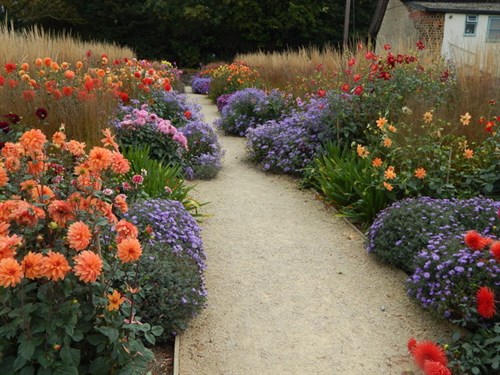A Sensational September
Friday, October 3, 2014
This month's headline is the easiest I have ever had to compose
- it says it all! No reservations, no "iffs" and "buts" no
"difficult to please gardener", just perfection. So settle back and
enjoy September with me. The cooler, wetter August held back many
later flowering plants and also delayed second flushes on roses and
many herbaceous perennials. When the weather picked up in early
September everything went absolutely bonkers and continues to do
so. There is more time to enjoy the garden now and to get on with
the most important autumn task of all - getting in the firewood for
winter. This has been made much easier with the loan of a large log
splitter from Rob the lawn guru.
A shot across 2 borders including from front to back,
crocosmia "Emily McKenzie", rudbeckia var.sullivantii "Goldsturm",
dalias "Karma Choc" and "Wittemans Best" pale pink rosa "Spirit of
Freedom" and in the top left hand corner the superb shrub cercis
canadensis "Forest Pansy"
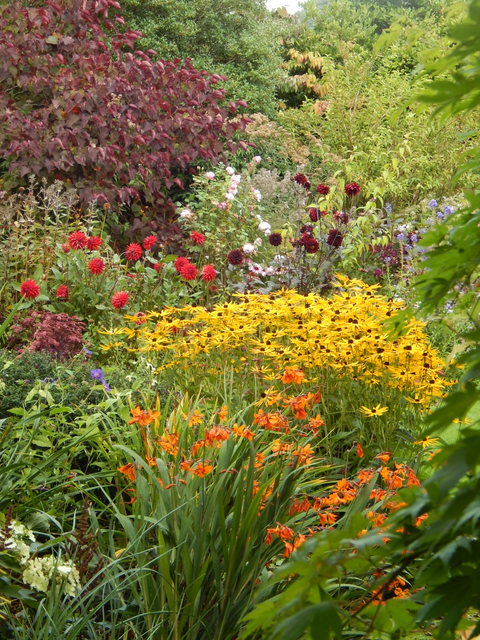
With the dry weather I could at last cut up the large oak tree
at the top of the hill behind the lodge. It had been an ever
present view since I came here in 1976 and it was sad in some
ways to see it reduced to logs in the space of a couple of days.
Very hard air dried wood with such a heady scent when cut; even the
heart wood in the trunk 4feet in diameter was dry. Counting the
rings, which is not that easy in a slow growing tree, revealed that
it was approximately 170 years old.
The stark silhouette
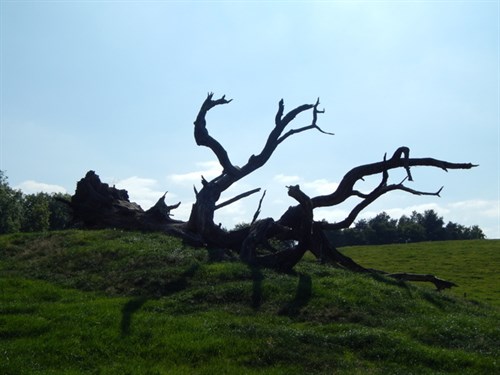
Work in progress
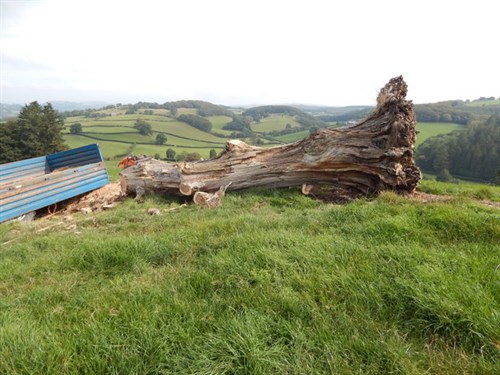
And a sad end for a noble tree which yielded 5 tons of
prime firewood. Thanks old friend.
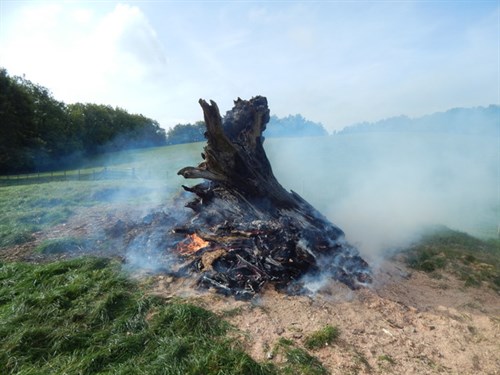
Weather
Four rain days in the month says all you need to know. The
defining weather features were pleasantly mild days and nights,
light winds and until the last week of the month no risk of frost.
It is officially the driest September for 50 years. Max 21.6c Min
5C
Garden update
I am more relaxed about the gardens at this time of year with no
visitors to prepare for or essential garden tasks to
complete. I continue to dead head and weed when necessary but
I don't go overboard. I make plans for next year deciding what
changes to make to the borders to keep them looking fresh and in
balance, and gather seed and take cuttings before the winter sets
in. The lawns I scarified and top dressed last month have been very
slow to recover and the seed has not germinated well so there are
some embarassing bare patches. This is surprising given the fine
weather and all the irrigation I have done. In the end they will
probably be OK but it doesn't stop me having some concerns.
Vegetables continue to give great crops in a wide variety (18 in
total at present). Sweetcorn is amazing with an average of 2 cobs a
plant with the later sown plants now in their prime. Plenty of fine
brassicas and Brussels Sprouts,variety "Brilliant", have well
formed buttons that are ready to pick. Huge celeriac, courgettes,
runner beans and ridge cucumbers coming out of our ears and avenues
of tomatoes (35 plants in all) in the tunnels. As good a vegetable
year as I can remember and if proof were needed, some of the best
cauliflowers and celery I have ever grown. They are generally
considered to be 2 of the most difficult vegetables to grow
well.
The archway of tomatoes "Rosada" a small plum, and
"Gourmet" of standard size, which lives up to its name - with
superbly flavoured, juicy fruit. A winner from Unwins. The plants
are supported by string up to the ridge of the large tunnel (9 feet
tall). 12-14 trusses on Rosada, less on Gourmet
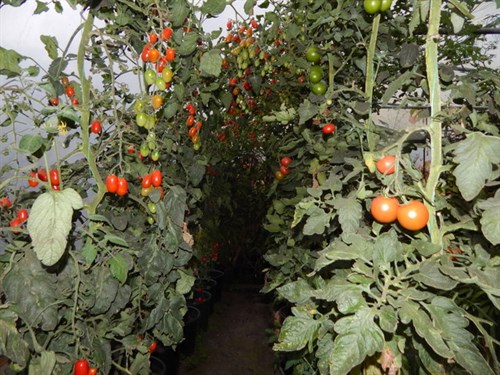
Moira's handiwork on the onion ropes "Sturon" a reliable
old favourite on the left, and an excellent red which didn't bolt
like "Red Baron" but I am embarassed to say I have lost the name of
it! Old Age!! The larger onions are taking longer to dry and will
be strung in the next couple of weeks.
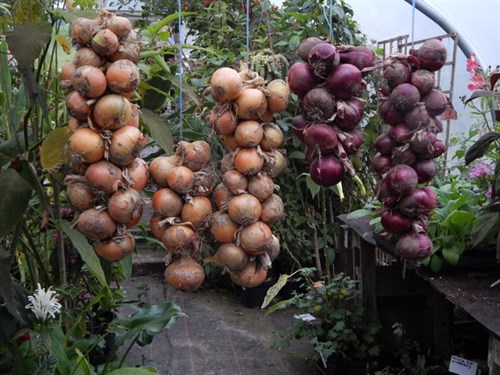
The final pickiing of pea "Hurst Green Shaft" on 21
September from a late sowing at the end of June. Some mildew
towards the end but a good crop. Only 2 rows of 5 achieved
this; the others fell prey to mice, rabbits or both.
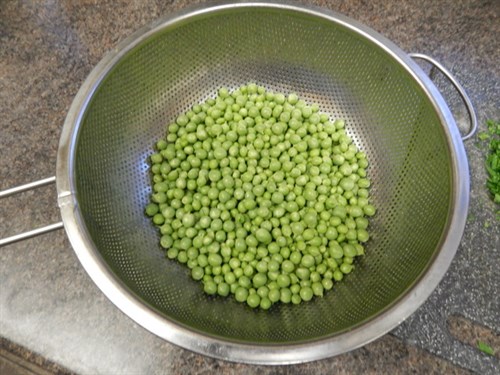
An incredible crop of courgettes from a mix of green
forms and the yellow "Gold Rush". By picking them every day and
sharing them with friends and neighbours has ensured we have had no
marrows to date and still they are cropping well. The glut has made
us look for new recipes which has included Moira's fantastic
Courgette and Creme Fraiche Bake with 4 eggs, Gruyere cheese and
parsley. Very light in spite of the rich ingredients
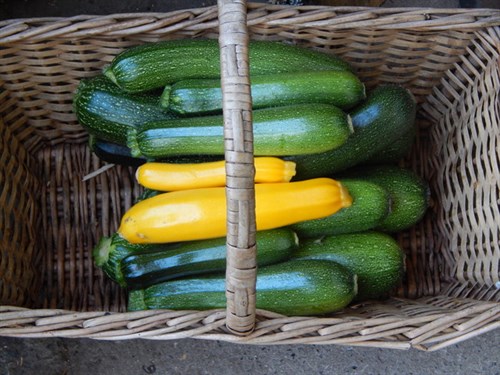
Few pests and diseases to worry about with no rabbit or squirrel
visitors which is a big plus. A few cabbage white butterflies have
succeeded in hatching caterpillars but they were quickly disposed
of. The biggest pest for the last 4 months has been red spider mite
for which there is no treatment available to non - professionals.
It is most prevalent in the polytunnels where its preferred host is
brugmansias which are ofetn totally defoliated and yet they still
flower. Even outdoors where there has been little rain to deter
them,in addition to brugmansias they have also become established
on the petunia hanging baskets.
The destructive effect of red spider mite on one of the
7 hanging baskets around the verandah on 3 sides of the
Lodge.
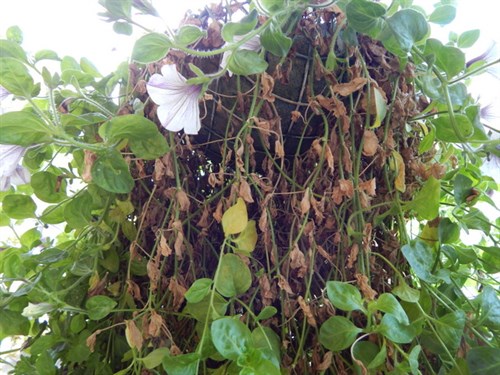
The borders look so colourful they give us a warm glow every
time we walk down them. The absence of rain has ensured that all
the plants with upward facing flowers (roses and daisy family
members in particular) have held in good condition for far longer
than usual, as tricyrtis, hesperantha (Kaffir Lily), sedums and
colchicums get into their stride. Shrubs and trees are showing good
leaf colour much earlier than last year and there are some fabulous
berries in the gardens and wider countryside.
Part of the Paddock shade border which really comes into
its own own in autumn with annual and perennial rudbeckias,
achillea "Cloth of Gold" and a selection of blue
asters
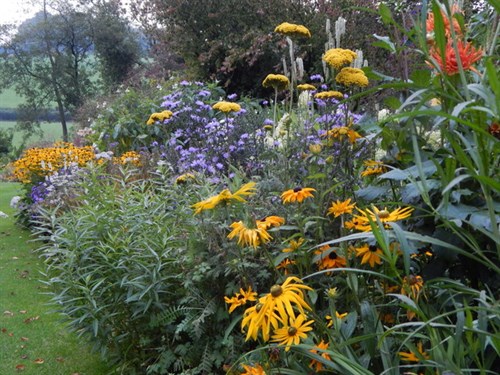
The fine weather has been welcomed by colchicums and it
was so good to see "Waterlily" a popular multi petalled form not
damaged by any heavy rain. This clump from just one bulb planted
about 10 years ago. As I get older I now plant them out in large
groups for more instant effect
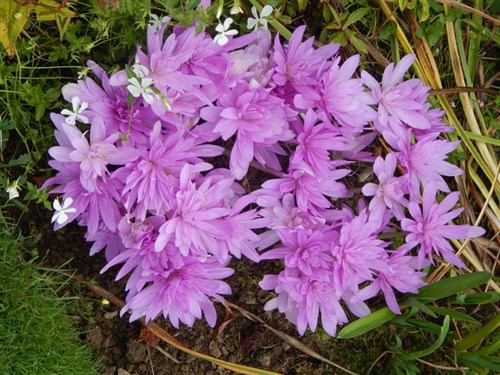
The fabulous dolls eye berries of actaea
pachypoda, a moist shade lover. Late into growth in late May
followed fairly soon after by dainty small bottlebrush flowers to 3
feet
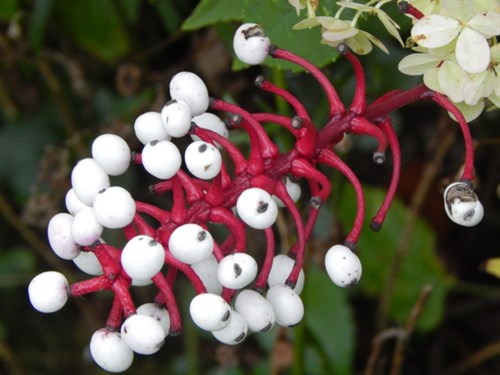
An attractive seed pod belonging to arisaema cilatum
liubaense which has done incredibly well for me in the shade border
alongside the conservatory. One of about 20 forms of arisaemas
dotted around the gardens. Thanks to our friend Tony, owner of a
great nursery www.shadyplants.com
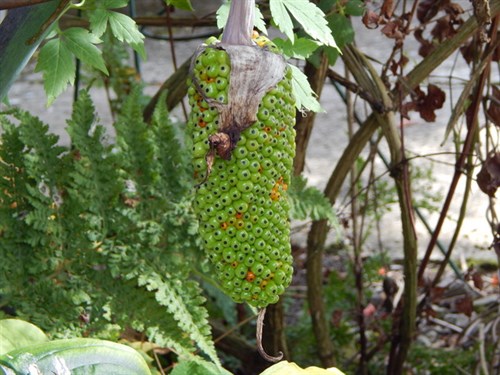
What's looking good?
The usual stalwarts of autumn at Cilgwyn - asters of course in
greater numbers and variety than ever before , salvias, colchicums,
clematis, dahlias and rudbeckias all revelling in this fabulous
weather. Plenty of pics, this time instead of lots of words, a
suggestion of one of the regular visitors to our website. Thank you
Sylvia!
Part of the long south facing Paddock Border with a
dazzling array of asters, hydrangeas, salvias, sedums,
verebena bonariensis and roses
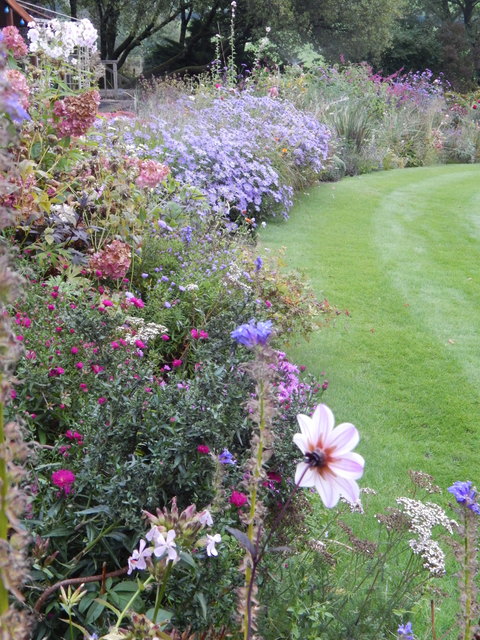
A close up of part of this border feauturing asters of
varying heights and colours, the dominant group in the towards the
top right hand corner is aster frikartii "Monch" which has become a
huge clump from seven plants in just one year. In the foreground
are aster nova belgii cultivars. pink "Waterperry" and the red
"Helen Ballard". Incidentally some of the aster genus is being re
-classified. The most significant change from 2015 is that asters
nova belgii and nova angliae (Michaelmas Daisies) are to be known
as symphiotichum. Still in the asteraceae family but a new
genus.
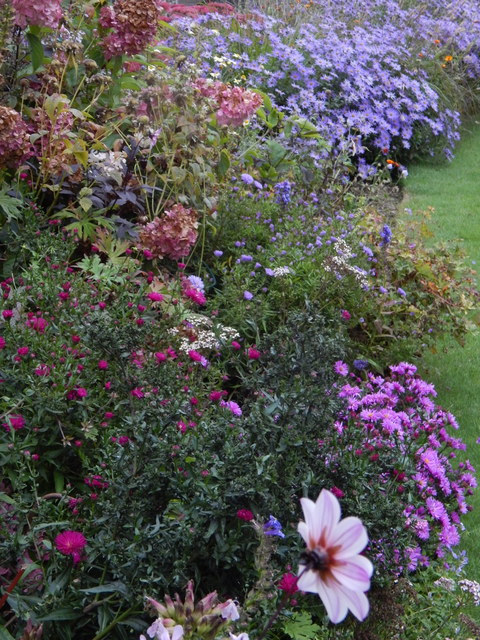
Not all asters are blue or pink. I have had this lovely
white nova belgii form for many years but unfortunately the name is
lost. Just enjoy!!: it as Christopher Lloyd once famously remarked
when asked by a visitor the name of a phlox planted by his
mother.
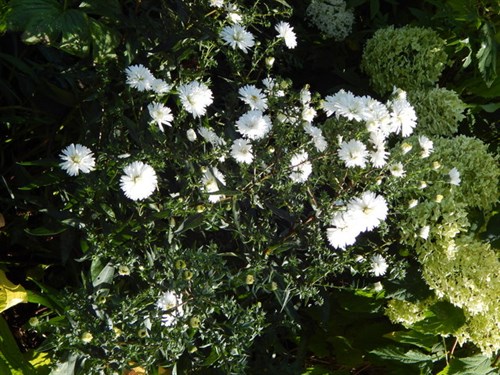
A real taste of autumn comes with the vivid blue
of the aconitum carmichaelii in the Cottage Garden Border by the
picket fence. It's partner here in a delicate shade of light pink
on wiry stems is aster "Star of Chesters" from the wonderful
nursery and garden at Old Court Nurseries, Colwall,
Worcs.
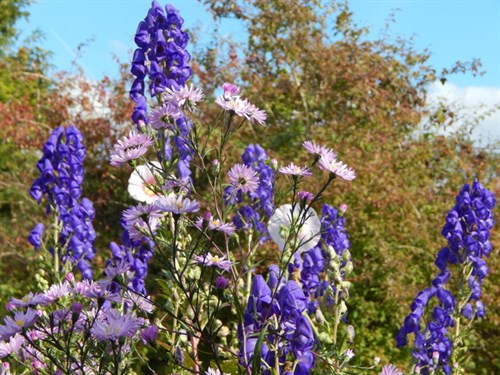
A small shrub I am fond of is indigofera in
various forms which has proved difficult to get established here.
Athough it is hardy it does get badly set back by cold winters and
cool summers. This year however it has had just the conditions it
likes and has grown well and flowered tremendously. This is one of
the best; indigofera howellii with generous late racemes of pink
flowers on a bush now 3 feet tall.
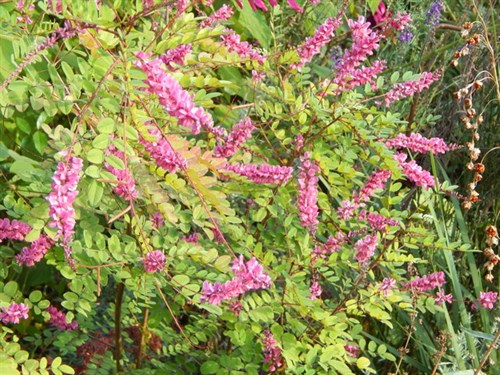
The sunny well drained Koi Pond Border with its sharply
drained soil is ideal for a whole host of borderline plants
especially salvias, together with sedums and kaffir lilies (now
hesperantha)
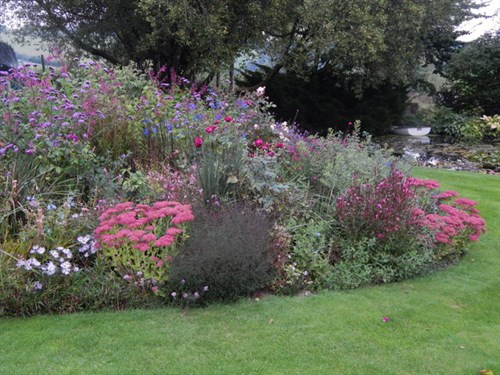
In this border is this lovely combination of
verbena bonariensis, pink salvia imvolucrata and the intense blue
of salvia patens "Guaajuato" at over 4 feet tall
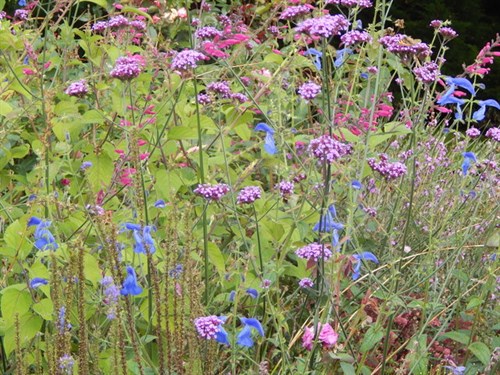
The late show with lots of red dahlias in the Red Border
- what a surprise!! This border only really comes alive when the
dahlia get going, particurlarly the blackish ones which bind all
the shades together
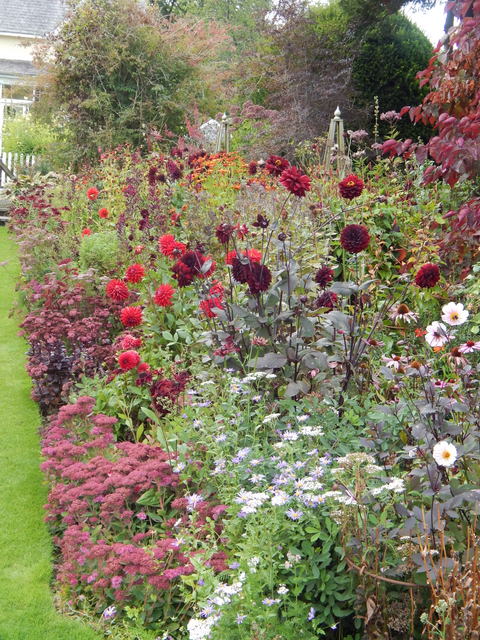
Dahlia "Lilac Time"
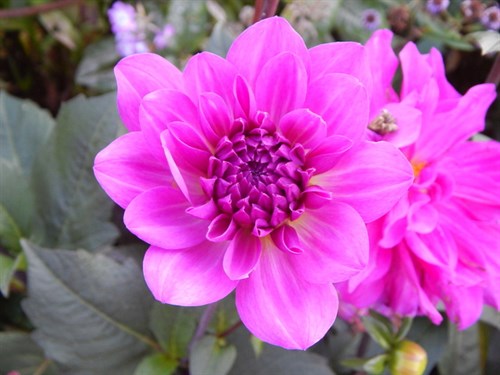
The elegant and highly sought after late flowering
umbellifer selinum wallichianum with ethereal white frothy
flowers and red stems to 5 feet. Likes some shade and retentitive
soil
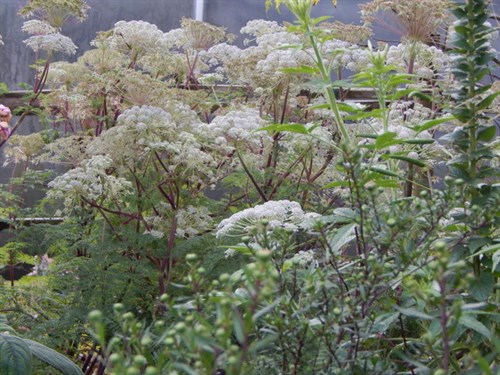
There are over 15 clematis still in flower in the
gardens too numerous to list them all.
One that I always show at this time of year is c.
rehderiana a very vigorous clematis which spreads far and wide
across fence panels and shrubs around the conservatory, Scented it
attracts masses of insectsand flowers until late
October
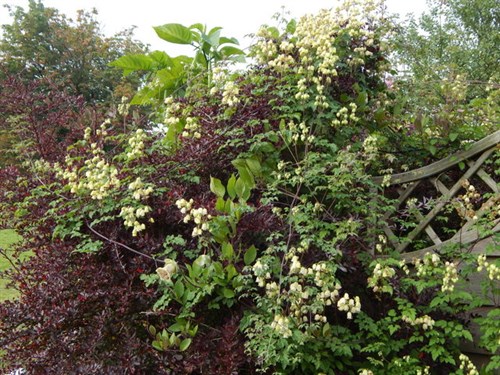
Not all clematis are climbers and there are some good
herbaceous forms. This one came to me as seed from The British
Clematis Society as c. tubulosa which is more
like a shrub with permanent woody base and lovely urn shaped bliue
flowers late summer and autumn.
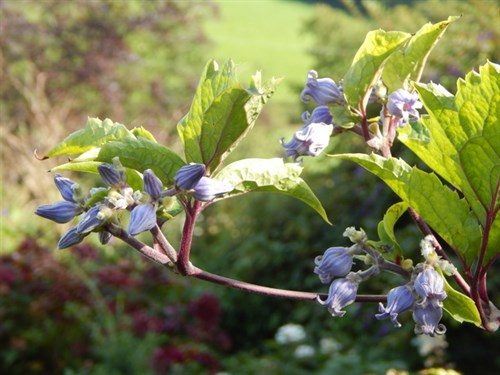
And this one is c. x jouiniana a scrambling herbaceous
form covering the framework of a cut back scabious cephalaria
gigantea, an early summer flowering perennial
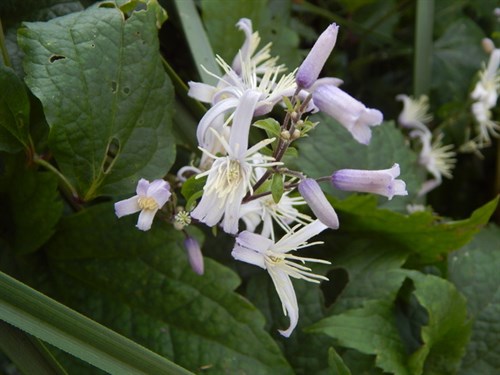
Countryside and wildlife
The dominant feature of early autumn has been how quickly this
year many of the native shrubs and trees have changed colour, and
what an amazing crop there is of berries and nuts. Hawthorns are on
fire with deep red berries and there are masses of blackberries and
rosehips. Guelder rose berries in hedges and roadside verges and
even early in the month the leaf colour on elders and spindle trees
(euonymus europeus) was spectacular. The dry weather also meant
that some trees and shrubs started dropping their leaves before
they even started to colour.
With the drier weather butterflies returned at last, although
not in huge numbers as might have been expected. I was so pleased
at last to see some Painted Ladies making a bee -line! for the
asters. Small tortoiseshells and Meadow Browns were numerous too
but that was about it. Bees in variety were of course active most
days principally on sedums, asters and verbena bonariensis.
A Painted Lady on aster amellus "Sonora"
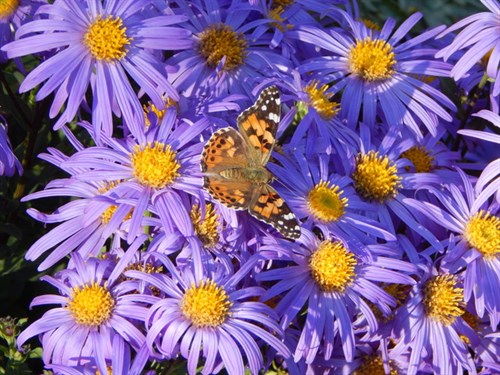
Since I have started on the firewood it seems that almost every
log I turn over in the woodpile has something of interest
underneath it, some very mundane like woodlice or ground beetles,
but often a developing frog or toad from this years breeding.
Two herons are regular visitors along the riverbank at the
bottom of the garden, along with dippers and grey wagtails. I
haven't seen or heard a kingfisher for a couple of months. I have
however seen a sparrowhawk coursing the hedges round the
gardens, striking terror into most birdlife, even the pesky magpies
which go around in menacing groups of up to ten birds.
The mild nights have seen plenty of moths on the wing and it was
so good recently to have Julian Wormald a moth expert from Gelli
Uchaf, as a supper guest who was able to make positive
identifications for us and our other guests. Read his hilarious
blog about one particular encounter on his fascinating
website at www.thegardenimpressionists.wordpress.com
-go toTag archive 7/9/2014 entitled Canary Shouldered Thorn
moth
Dusky Thorn moth an additional guest at the supper
table!
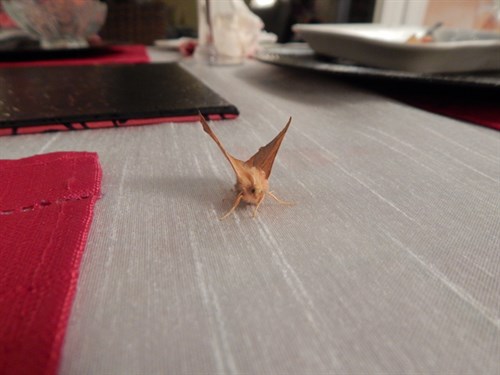
Visits and visitors
The gardens have now closed until June 2015 when we will be
opening once again, by prior arrangement, for the National
Gardens Scheme. If you would like to make an early booking for the
date you require please get in touch. Please note that late June
and the whole of July are usually the 2 most busy times
A visit to Picton Castle near Haverfordwest in Pembrokeshire
early in the month was an absoloute delight, as always. It prides
itself quite rightly on being a garden for all seasons as there is
always something special to see with an excellent cafe and plants
for sale from material in the garden. It exudes passion, variety,
originality and a high standard of maintenance - quite an
achievement in a 40 acre garden. For these reasons it is, in our
view, one of the best gardens in the whole of Wales. As it
closes at the end of September make sure you pay a visit when it
opens again in April next year. It was a pleasure at last to meet
the head gardener Roddy Milne at a recent NGS function and to have
the opportunity to congratulate him and the trustees on all the
fine work they are doing there.
Gay abandon and free form planting in theTropical Garden
at Picton Castle
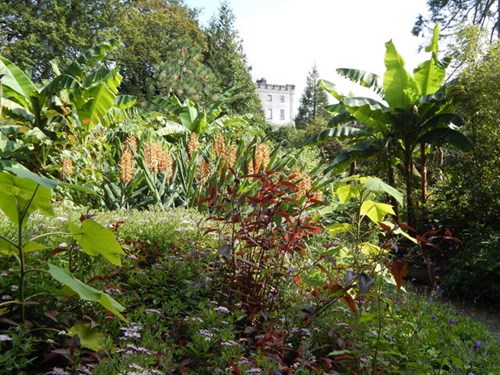
Lovely struture and form in the Walled
Garden
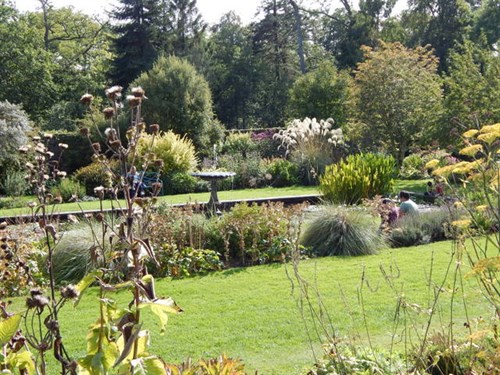
Another visit was to the coast at last, for some ozone and sand
between the toes as perfectly evoked in Dylan Thomas' poem "August
Bank Holiday" :... " a slap of sea and a tickle of sand"
The wonderfully named Poppit Sands near
Cardigan
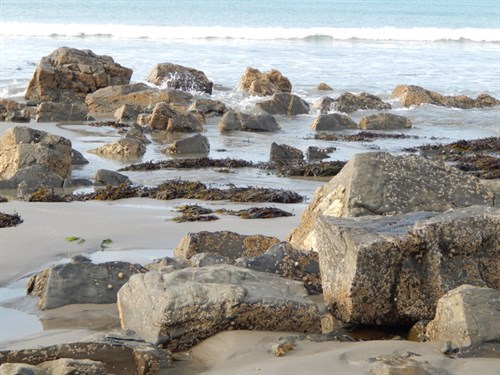
Right at the mouth of the River Teifi, one of the great
rivers of Wales, there is a huge expanse of sand at low tide
looking across to to the superbly sited Cliff Hotel, Gwbert on the
cliffs opposite

And the jewel in Cardigan Bay is Aberystwyth, now
recovered from the storms of last winter which saw it featured on
almost every news bulletin. Who can forget the pictures of some of
these houses being battered by the waves. The only battering we saw
on a glorious day was the superb fish and chips in the promenade
cafe!

The garden talks season has started in earnest with 4 talks
during the month as far apart as St Clears in the west and
Llangynidr in the east - all well attended and received. The
most popular talk this season is "50 of My Favourite Hardy
Perennials" reflecting a resurgence of interest in the growing of
perennials. Please get in touch if you would like me to give
a talk to your club or society. For further details see under the
heading Nursery, Teas and Talks - see the tabs on the home page of
this website.
In the last weekend of the month we had another short break
going to Malvern Autumn Show, Kelmarsh Hall in Northamptonshire and
Aston Pottery in Oxfordshire - all for plant related inspiration. A
few pics below but more at the end of October when there will be
fewer visits on which to report..
Colourful visitors mingling with even more colourful
dahlias at Kelmarsh Hall
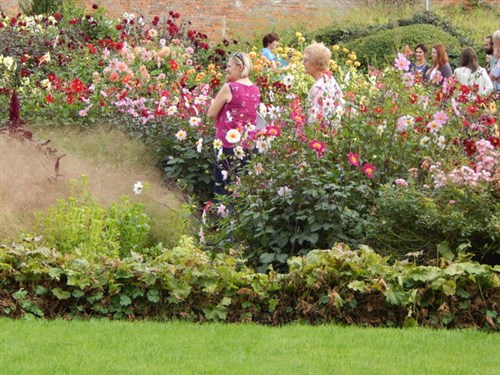
Exceptional structure and colour at Aston
Pottery
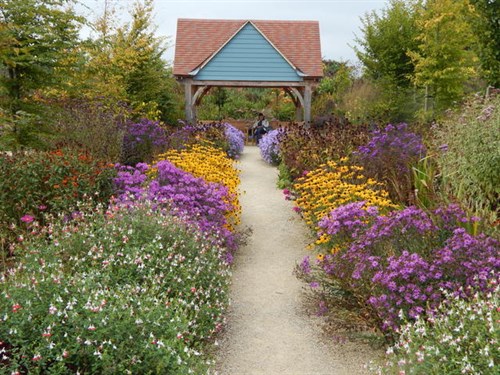
And yet more fabulous dahlias at Aston with asters and
grasses
